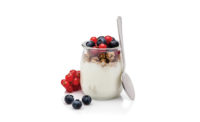
Dairy Foods talked to:
Lars Bredmose, marketing director-probiotic cultures, Chr. Hansen A/S
Michael Bush, vice president of business development, Ganeden Biotech Inc.
Bill Driessen, technical sales manager, Taiyo International Inc.
Lorraine Niba, business development manager, National Starch Food Innovation
Trina O’Brien, marketing and p.r. manager, GTC Nutrition
Joseph O’Neill, executive vice president sales and marketing, BENEO-Orafti
Arthur Ouwehand, technical manager, clinical documentation, Danisco
Lisa Sanders, nutrition scientist, Tate & Lyle
Julian Stowell, science director, Danisco Sweeteners
Neelesh Varde, business development coordinator, Roquette America Inc.
Grace Wang, food scientist, TIC Gums
Steven Young, North American technical advisor, Matsutani America
Editor’s Note: After returning from the International Scientific Association for Probiotics and Prebiotics (ISAPP) meeting in early November, I embarked on the editing of the following discussion of probiotic and prebiotic food and beverage ingredients. After two days of listening to scientists and clinicians present data and raise issues concerning probiotic and prebiotic research, including their criticism of how these beneficial dietary components are addressed in the media, I was feeling a bit cynical about writing this feature article. To regain confidence in the industry, I put on my scientist hat and remembered that researchers are ingrained to not conclude, only to suggest. Science is never absolute, it is only suggestive. We all have the same goal: to deliver probiotics and prebiotics to consumers in order to assist with improving their health and wellness. With some ingredients there’s more scientific “suggestion” than others. Food formulators must decide which probiotic and prebiotic ingredients to use based on the claims they want to make (structure-function, benefits conferred, viable cell count, fiber content claim, etc.), how the ingredient functions in the system and documented clinical studies. Hopefully the insight presented by the following 12 suppliers assists in your decision

"On Probiotics"
Dairy Foods: The Food and Agriculture Organization of the United Nations (FAO) and the World Health Organization (WHO) define probiotics as live microorganisms which, when administered in adequate amounts, confer a health benefit on the host. Do the cultures that your company markets as probiotics meet this definition?Ouwehand: Strains and blends in Danisco’s probiotic line do meet the requirements set forth in the FAO/WHO definition. In addition to these strains, we have emerging probiotics that do not yet meet all the requirements from the definition. Studies to bring them up to this level are continuously ongoing.
Bredmose: All of Chr. Hansen’s cultures meet the FAO/WHO definition. They are all very well scientifically documented for their health benefits and we always take care to advise our customers about recommended daily amounts of probiotic cells to ensure the health benefits.
Bush: Yes. Our primary probiotic strain-Bacillus coagulans GBI-30, 6086-is a live microorganism that his been shown in multiple double-blind, placebo-controlled studies to confer health benefits to the host.
Dairy Foods: Do you believe this is a valid definition or would you like to see it modified?
Bush: This definition is valid but we believe that it will continue to evolve over time.
Ouwehand: We feel this is a valid definition and hence we adhere to it. Nevertheless, with increasing understanding of the properties of probiotics and the mechanisms by which they work, the validity of the definition will need to be monitored.
Bredmose: We believe this definition is accurate and protects consumers.
Dairy Foods: What are the greatest challenges probiotic suppliers face today?
Bredmose: Regulatory authorities are putting more focus on ensuring that the health claims made on food products containing probiotics are backed by high-quality clinical data. This marks true progress for consumer protection and Chr. Hansen fully supports these activities. We work with our customers to ensure that probiotic-containing products are backed by scientific evidence. Communicating the benefits of probiotics can be a challenge because not all consumers are equally aware of the importance of our gut flora on our general health and well-being.
Bush: Challenges are many and varied but two of the biggest are ensuring the viability of cells in products and through the shelflife of these products; and ensuring the cells we consume actually survive the transit through the stomach so that the consumer receives the promised benefit of the purchased probiotic product.
Ouwehand: The whole process from identifying and substantiating health benefits to getting the message across to the consumer is in itself a challenge.
Dairy Foods: Please identify the strains of probiotics your company sells and what are their claims to fame.
Bredmose: Bifidobacterium animalis subsp. lactis originates from Chr. Hansen’s collection of dairy cultures and has been used since the mid-80s as an ingredient in food and food supplements. It is broadly tested in clinical studies from newborn preterm infants to elderly. Ongoing clinical development and more than 120 scientific papers document its benefits on gastrointestinal health in humans. It has superior performance properties in dairy products. In Japan it has FOSHU approval, and in the States it is generally recognized as safe. Lactobacillus paracasei subsp. paracasei was originally isolated from infants. It has been used since 1995 as an ingredient in food and food supplements and has been tested in numerous clinical studies with subjects aged five months and up. Many independent studies have shown it to boost the immune system when ingested regularly in adequate amounts.
Ouwehand: Bifidobacterium lactis HN019 and Lactobacillus rhamnosus HN001 are the only probiotics that have been specifically selected to modulate the immune system. This property has been confirmed in numerous human studies in different research institutes. Lactobacillus acidophilus NCFM is among one of the oldest probiotics strains-the archetype probiotic. The strain has been widely investigated for its intestinal health benefits in numerous human studies. Furthermore, the strains are stable in a variety of applications, including non-dairy foods.
Bush: Bacillus coagulans GBI-30, 6086 is our patented probiotic strain. The claim to fame is our strain’s ability to survive extremes in processing and have a very long, stable shelflife. It can be used in products that are simply impossible with other strains. For example, we are able to inoculate dairy products pre-processing in HTST-processed milk and we get great survival of the strains at the end of shelflife. We are also able to use it in applications such as baking, processed and non-processed cheese, hot and high-pressure applications.
Dairy Foods: What do you think is in the future for the probiotics industry?
Ouwehand: Probiotics have a bright future. There is a wealth of data on the health benefits of probiotics and meta-analyses clearly show the areas where probiotics may provide benefits for the consumer.
Bush: The future of the probiotic industry is bright and getting brighter each day. We see continued growth of probiotic-fortified products and we see the dairy category as one of the key growth drivers. But we also see a large growth opportunity outside of traditional dairy applications.
Bredmose: Consumers connect the health benefits and strain names with dairy products. However, we are seeing and also supporting a diversification into other food matrices. We do believe that new carriers of probiotics and associated health claims must be inherently healthy in order to succeed on the market. Consumers will rarely accept health ingredients and functionality in products they perceive as less healthy.
“On Prebiotics”
Dairy Foods: ISAPP defines prebiotics as non-digestible substances that provide a beneficial physiological effect on the host by selectively stimulating the favorable growth or activity of a limited number of indigenous bacteria. Do you believe this is a valid definition?
Niba: The definition is cognizant of the evolving science of fiber’s physiological activity. It is up-to-date with the science and is therefore a suitably valid definition.
Driessen: It is correct; however, it does not quantify the prebiotic effect. Because there are so many different products being produced and offered, it is important for producers to further explain, describe and quantify the prebiotic effect of their products. To this extent, it would be helpful for some governing body to set standards about how companies can measure the prebiotic effect of their products and compare them to others.
Young: I would like to see the inclusion of beneficial bacteria ingested as well as indigenous, beneficial bacteria.
Ouwehand: I prefer the simple definition of Gibson and Roberfroid (1995): Prebiotics are non-digestible food ingredients that selectively stimulate a limited number of bacteria in the colon, to improve host health. This was updated by Gibson et al (2004) to include: in order to qualify for prebiotic classification, a compound is required to resist gastric acidity, hydrolysis by mammalian enzymes and gastrointestinal absorption; to be fermented by the gastrointestinal microflora; and to stimulate selectively the growth and/or activity of intestinal bacteria associated with health and well-being.
O’Neill: The ISAPP definition should be modified to be more specific. The prebiotics that currently meet criteria set forth by this preferred definition-Gibson’s-are inulin, oligofructose, short-chain fructooligosaccharides, galactooligosaccharides and lactulose.
Dairy Foods: What are the greatest challenges prebiotic suppliers face today?
Niba: It’s communicating the benefits of colonic fermentation to food manufacturers and subsequently consumers. A second challenge is establishing dose efficacy of prebiotics in a food matrix.
O’Neill: Prebiotic suppliers have a great opportunity to influence the health of the consumer throughout all life stages. It is important to understand the needs of the consumer in whatever food category the prebiotic is available. With various concepts, wordings and well-chosen phrases, we help our customers by testing, evaluating and recommending claims to communicate the benefits of the prebiotics in a simple and effective way. Investing in clinical research, regulatory insights and marketing and R&D expertise is expensive. As a pioneer in the industry, BENEO-Orafti has been involved in these areas to support our customers in developing the health and well-being market. It remains a sales and marketing challenge when the customer does not fully understand the value or great potential of the prebiotic.
Sanders: An opportunity for prebiotic suppliers is to promote consumer education. Research shows that most consumers don’t understand or haven’t heard of prebiotics, but are relying on labels to get health information about the products they are purchasing.
Wang: The bioactivity and efficacy of prebiotics during and after processing/storage needs to be better understood since each fiber source reacts differently in food systems. Additionally, each country has its own regulatory specifications for whether or not hydrocolloid-based fiber systems can be declared by manufacturers as fiber/prebiotic sources.
Varde: Consumer awareness is critical in marketing prebiotics, including differentiation of prebiotics and probiotics, and insoluble and soluble fiber. Satiety and its role in weight management will emerge as a huge consumer force in the coming years.
O’Brien: One of the main challenges that prebiotic suppliers face today is ingredient differentiation. Inaccurate messages and communications have blurred the line among different prebiotic ingredients. To understand the role of prebiotics in promoting health, one must become familiar with the different types, their origin, structure and function. This is the foundation that will support good choices for formulators and consumers alike.
Dairy Foods: What type of prebiotics does your company sell and how do they function?
Stowell: Polydextrose is highly versatile in a wide range of food matrices. It is also cost-effective. Lactitol has excellent technological functionality as a sugar replacer.
Varde: Resistant dextrins offer a high degree of dietary tolerance. In addition, resistant dextrins are stable in acids and to high heat. They are completely neutral in taste, so they can be easily added to an existing product without having to readjust a flavor balance.
Niba: Natural resistant starch is fermented by colonic bacteria to produce short chain fatty acids. It produces proportionally higher levels of the fatty acid butyrate, which has been shown to have the most physiological benefits. It also has excellent digestive tolerance because of its structure and the nature in which it is fermented. It therefore does not cause digestive discomfort like some other fibers.
Driessen: Partially hydrolyzed guar gum is highly stable in low pH environments. It is completely soluble, tasteless, odorless and does not impart sweetness or alter viscosity.
O’Brien: One of our soluble fiber ingredients contains a minimum of 95% short-chain fructooligosaccharides. We also have a prebiotic derived from lactose that contains a minimum of 90% galactooligosaccharides. These are naturally occurring oligosaccharides in human milk that contain glucose and repeating galactose units. The ingredient has been shown to support immune system strength and overall well-being. It is highly soluble, stable to high heat and low pH, and offers efficacy at low inclusion levels. There’s also active agave fiber, which is a plant-derived source of inulin that provides unique functional benefits to food and beverage applications. It features a branched structure, high degree of polymerization and provides superior stability in liquid form.
Young: Digestion resistant maltodextrin is only partially fermented in the colon and fermented at a slow enough rate to allow growth of beneficial bacteria without development of gastric distress.
Sanders: Soluble corn fiber is process-stable, colorless, tasteless and an easily dispersible ingredient.
Wang: Hydrocolloid-based soluble fiber sources not only contribute to the growth of beneficial flora in the gut but can also help to lower cholesterol, modulate blood glucose levels and reduce the risk of atherosclerosis, as found in nutritional studies.
O’Neill: We offer oligofructose in powder and liquid form with degree of polymerization levels ranging from two to eight and fiber contents between 85% to 95%. In addition to being a source of fiber, it can replace sugar, potentiate flavors and mask off notes associated with high-intensity sweeteners. Oligofructose is also used as an all-natural sweetener in dairy applications. Native inulin products are invisible sources of prebiotic fiber. They provide fat and sugar replacement opportunities in yogurt, smoothies and in frozen desserts. In addition, BENEO-Orafti has designed specialized products with short-, medium- and long-chain lengths in a defined ratio so the product is fermented. Such new products include a patented form of oligofructose-enriched inulin that is approved for use in organic products and is clinically proven to boost calcium absorption, increase bone mineral density and lower the body mass index of teenage adolescents.
Dairy Foods: So what is the future for the prebiotics industry?
Driessen: People are and should continue to be interested in increasing their fiber intake. But, fiber is often times not perceived as exciting, interesting or cool by consumers. However, a much greater cross section of society can relate to a desire for improved digestive health.
Wang: There is good potential for growth for the prebiotic industry, as consumers focus more on digestive and gut health.
Varde: Dairy foods as a medium will continue to be at the forefront as carriers for new trends, innovations and claims for the prebiotics industry.
Probiotic Cottage Cheese Now with Prebiotic
Friendship All Natural Digestive Health Cottage Cheese with probiotics now delivers digestive and bone-health benefits by offering added dietary fiber in the form of oligofructose-enriched inulin. This enriched-prebiotic fiber derived from chicory roots has been shown to help stimulate the growth and activity of beneficial bacteria in the digestive tract. Further, it has been clinically shown to provide an extra boost to calcium absorption and bone health, as compared to regular inulin.
A half-cup serving delivers one billion live active probiotic (Bifidobacterium) cultures, is a good source of calcium and prebiotic fiber (10% Daily Value) to support healthy bones, and is rich in protein (28% Daily Value) to help build and maintain muscle tissue.
“We’re seeing increased consumer demand for products that provide more natural attributes as well as products that contain functional nutrients that deliver healthy benefits. We are pleased to now offer an all-natural cottage cheese product with digestive and bone-enhancing nutrients, while maintaining our product standards in quality, taste and freshness that our consumers have come to expect,” says Paige Pistone, director of marketing at Friendship Dairies, Jericho, N.Y. “We look forward to a continued commitment in bringing innovation to our all-natural line of cultured dairy products.”


